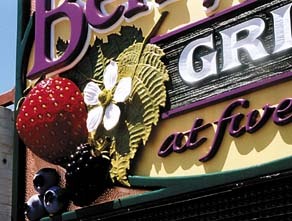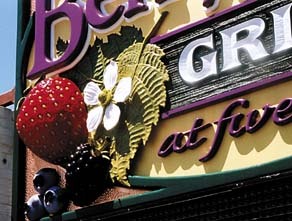Dimensional Signs
HDU Exposed
The facts about the staple material of many dimensional signshops
Published
18 years agoon

Twenty years ago, fabricating an exterior-grade, dimensional sign from something besides a hardwood (such as mahogany, redwood or cedar) would have seemed as far-fetched as using a digital printer to fabricate a billboard design, or decorating a shop truck with vinyl. However, high-density urethane (HDU) usage has become so widespread that using wood to create signage seems like an antiquated activity on par with calligraphy or playing baseball by Abner Doubleday’s rules (the winning team had to score 21 runs, and a runner could be retired by merely pelting him with the ball). After first earning acclaim in aeronautical and heavy-industrial usage, HDU began appearing in the sign industry in the late ’80s, when fabricators yearned for a more workable material. Also, as demand began exceeding supply, the availability of quality redwood diminished, which made finding a suitable piece a daunting task. Once signmakers became familiar with HDU’s workability and versatility, it quickly filled the void. Representatives of two HDU manufacturers, and two signmakers who make their living with the substrate, explain why its versatility helps them thrive. The manufacturers Sign Arts Products Corp. (Dana Point, CA) first introduced urethane in the late ’50s. NASA successfully tested the product and used an approximately 3-lb. material as exterior insulation in the launch of the Saturn S-II in 1964. Urethane became a structural-insulation fixture within the aerospace and boatbuilding industries, and the company introduced SignxFoam to the industry in 1988. The move was significant, because it was the first time urethane had been offered to a consumer market. Before that, urethane had only been known for industrial usage. According to Chuck Miller, who founded Coastal Enterprises (Orange, CA) approximately 30 years ago, his company has offered Precision Board — its HDU product — to signmakers for approximately 13 years. He notes that various types of urethane exist, with uses ranging from coating a couch’s upholstery to being molded into wheels for inline skates.
HDU’s density is measured in pounds per cubic ft.; in its raw state, the material’s density is 68 lbs. Densities can be reduced to approximately 4 lbs. by "blowing" the HDU.
In the process, once a chemical formula is created, the liquid is poured into a large mold and cast into a bun. A blowing agent serves as a catalyst, activating other chemical components. When they’re activated, the substances rise, and tiny bubbles of carbon dioxide form, turning the urethane from its initial state into a foam. The urethane stabilizes after cooling and forms in large blocks that are cut into 4 x 8-, 4 x 10-, 5 x 8- and 5 x 10-ft. panels and to a signmaker’s desired thickness.
After this reaction, the urethane has a closed-cell structure — which enables resistance to damage — comprising millions of tiny cells. These cells create a lightweight structure that’s inert and unaffected by temperatures or commonly used solvents.
HDU is manufactured in 4-40-lb. densities. Less dense material may be used for such applications as cut-out letters and large carvings, while a more dense substrate would be suitable for signs in such high-traffic areas as swimming pools and golf courses. However, the most common densities are 10, 15 and 18 lb.
"Higher density means higher material cost," Miller explains. "Jobs are won and lost by the density that a sign company chooses."
AdvertisementJoe Scienski, SignxArts Products’ sales and marketing vice president, notes that approximately 70-75% of his customers use 15-lb. material; however, each is suitable for different types of projects.
"For large, complex jobs that require heavy machining and broad designs with sweeping lines, 10-lb. material would provide less resistance and probably increase productivity," Scienski explains. "When strength and installation are concerns, however, heavier material is preferable."
Scienski notes that many longtime signmakers — particularly in the Northeast and New England — who learned their craft on hardwoods, typically prefer 18-lb. HDU, because "they became accustomed to chisels, gouges and other tools working a certain way with the substrate, and the heavier density provides the same feel."
Because of its inorganic components, HDU is impervious to moisture — and thus doesn’t permit the growth of dry rot or fungus — and can withstand temperatures from -423° to 200° F. Miller says that the raw substrate will last 30-40 years in normal outdoor conditions, and indefinitely if painted.
Because it’s a manufactured substrate, HDU is free of knots, warping and other defects endemic to wood. Further, it has greater machineability, because there’s no integral grain within the product, which allows urethane to perform consistently with routers, chisels or whatever cutting tools the signmaker uses.
"If you’re carving a letter in, say, mahogany, at some point, you’re going to have to cut across the wood’s grain," Scienski explains. "There’s no such problem with HDU."
AdvertisementMiller also explains that upgrades in the material’s formulation, since its introduction to the sign market, include greater uniformity, simpler cutting and easier interaction with paint.
According to Scienski, when signmakers first began using HDU, they spent substantial time painting and finishing, then applying several layers of primer and sanding in between each coat, to eliminate its sandpapery texture. Subsequently, Sign Arts altered its cell structure to require less elbow grease to obtain a smooth surface. To create its latest version, the company fortified its integral strength by 60% to minimize denting and cracking potential.
"HDU has developed into its own substrate," Miller says. "It’s no longer simply a material that produces look-alikes to wood signs. It has become its own market, with its own complementary materials."
Such materials include specially designed paints, primers and fillers. When HDU debuted, no primers were formulated for it. Standard primers comprise 35% solids; multiple coats are needed to fill HDU’s pockmarked surface. However, primers designed expressly for the material contain 80% solids, which fill the surface and ensure a bond remains on the HDU surface.
Although versatile, HDU has limitations. Because there’s no integral beam strength, the material can’t be used for posts or beams, nor for very large signs that don’t include a support structure.
Signmakers’ most common mistake is blasting HDU signs too deeply, Scienski notes.
Advertisement"A prime example would be sandblasting a two-sided sign," he says. "If the material is 1 in. thick, and you blast 1/4-in. deep on either side, that leaves a net of only 1/2 in. of material. That’s far too much of a structural demand for a 4 x 8-ft. sign."
Another potential gaffe is applying paint too soon after priming. Because HDU is entirely nonporous and doesn’t absorb moisture, drying occurs from the outside in. Because it dries quickly on the surface, it’s possible to apply paint or a sandblasting mask before it’s completely dry. Applying either paint or mask to undried primer will result in the paint blistering when it’s placed in the sun. Also, maskant will pull off primer when it’s removed after blasting.
"I recommend always placing a large fan across from the substrate for at least four hours prior to applying paint or mask," Miller says. "The frictional heat of the air rolling over the surface will slightly heat the surface and draw out moisture."
Further, he notes that, although HDU looks like wood, it isn’t, and signmakers should contact urethane manufacturers for tips on the most efficient and economical methods of signage fabrication.
Thumbs up
Brother Zank, who founded Custom Craftsman Signs (Sevierville, TN) 15 years ago, regards HDU as one of his shop’s staple materials. When HDU entered the market, he received several material samples and immediately saw its possibilities.
"Its consistency is terrific; we always know how it will perform," he says. "Plus, it works with all our shops’ tools, so we’re able to allow some of our newer employees to carve signs. With redwood and its challenges, you almost need a master craftsman to work with its grain."
To bolster its signs’ structures, the shop often fabricates steel substructures that are concealed by the urethane.
Robby Rucker, a sign-industry veteran of more than 30 years, has operated Festival Sign Service (Gainesville, FL) with his wife, Janet, for 23 years. When he began using HDU in 1990, he could see the future of dimensional substrates.
"By that time, the quality of redwood had diminished," he recalls. "Most of the redwood being sold came from new-growth forests, and the strength just wasn’t there. We had to kiln-dry all our redwood, so there were handling issues as well."
Festival Sign Service fabricates scores of prismatic letters, which Rucker says are much simpler to complete with HDU because of its workability. To bypass the problem of obtaining a smooth finish, he says he’ll often laminate anodized aluminum to the surface, which provides a smooth surface without sanding.
A case for wood?
Andy Miller, sales and marketing manager for Allwood Sign Blanks (Errington, British Columbia, Canada), says that, although wood blanks comprise less than 5% of the sign-blank market, there are advantages to natural material.
"Even with a grain frame, it’s very difficult to emulate the beautiful grain of natural wood," Miller — whose company manufactures blanks from vertical-grain, western red cedar — says. "Also, I’ve heard that birds like the taste of HDU and will peck away at it, which is not good for aesthetics."
According to Miller, red cedar offers the same strength as redwood and is far more plentiful, particularly throughout Western Canada.

SPONSORED VIDEO
Introducing the Sign Industry Podcast
The Sign Industry Podcast is a platform for every sign person out there — from the old-timers who bent neon and hand-lettered boats to those venturing into new technologies — we want to get their stories out for everyone to hear. Come join us and listen to stories, learn tricks or techniques, and get insights of what’s to come. We are the world’s second oldest profession. The folks who started the world’s oldest profession needed a sign.
You may like

American Sign Museum Names New Executive Director

3 Things Print Pros Must Do to Build Stronger Relationships in the Interiors Market

Graphics Turn an Eyesore Cooler Into a Showpiece Promo in Historic Plaza
Subscribe

Bulletins
Get the most important news and business ideas from Signs of the Times magazine's news bulletin.
Most Popular
-

 Tip Sheet1 week ago
Tip Sheet1 week agoAlways Brand Yourself and Wear Fewer Hats — Two of April’s Sign Tips
-

 Photo Gallery2 days ago
Photo Gallery2 days ago30 Snapshots of the 2024 ISA Sign Expo
-

 Ask Signs of the Times4 days ago
Ask Signs of the Times4 days agoWhy Are Signs from Canva so Overloaded and Similar?
-

 Real Deal1 week ago
Real Deal1 week agoA Woman Sign Company Owner Confronts a Sexist Wholesaler
-

 Benchmarks6 days ago
Benchmarks6 days ago6 Sports Venue Signs Deserving a Standing Ovation
-

 Women in Signs1 week ago
Women in Signs1 week ago2024 Women in Signs: Megan Bradley
-

 Photo Gallery1 week ago
Photo Gallery1 week ago21 Larry Albright Plasma Globes, Crackle Tubes and More
-

 Women in Signs1 week ago
Women in Signs1 week ago2024 Women in Signs: Ashley Borell













